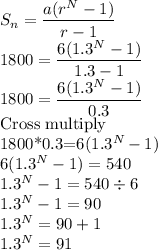Sarah is carrying out a series of experiments which involve using increasing amounts of a chemical. In the first experiment she uses 6g of the chemical and in the second experiment she uses 7.8 g of the chemical
(i)Given that the amounts of the chemical used form an arithmetic progression find the total amount of chemical used in the first 30 experiments
(ii)Instead it is given that the amounts of the chemical used for a geometric progression. Sarah has a total of 1800 g of the chemical available. Show that the greatest number of experiments possible satisfies the inequality:
 and use logarithms to calculate the value of N.
and use logarithms to calculate the value of N.
Answer:
(a)963 grams
(b)N=17
Explanation:
(a)
In the first experiment, Sarah uses 6g of the chemical
In the second experiment, Sarah uses 7.8g of the chemical
If this forms an arithmetic progression:
First term, a =6g
Common difference. d= 7.8 -6 =1.8 g
Therefore:
Total Amount of chemical used in the first 30 experiments
![S_n=(n)/(2)[2a+(n-1)d] \\S_(30)=(30)/(2)[2*6+(30-1)1.8] \\=15[12+29*1.8]\\=15[12+52.2]\\=15*64.2\\=963$ grams](https://img.qammunity.org/2021/formulas/mathematics/high-school/jvp2lqreho141da8fbpf4jg1ay3pgeejhg.png)
Sarah uses 963 grams in the first 30 experiments.
(b) If the increase is geometric
First Term, a=6g
Common ratio, r =7.8/6 =1.3
Sarah has a total of 1800 g
Therefore:
Sum of a geometric sequence

Therefore, the greatest possible number of experiments satisfies the inequality

Next, we solve for N
Changing
 to logarithm form, we obtain:
to logarithm form, we obtain:

Therefore, the number of possible experiments, N=17